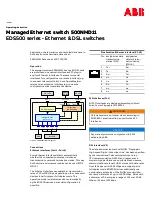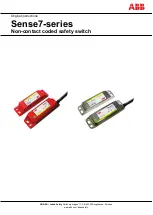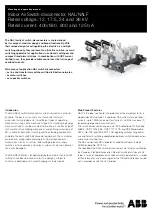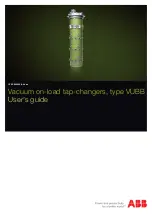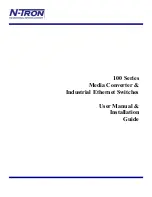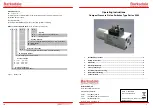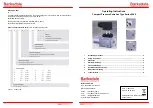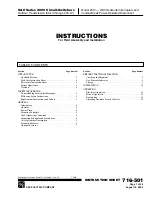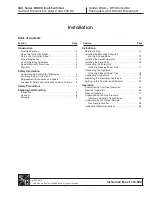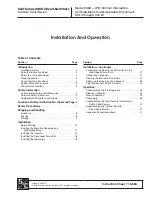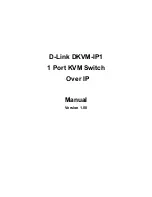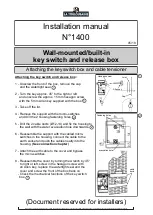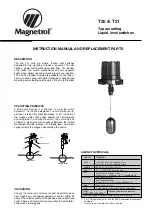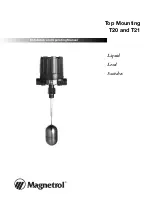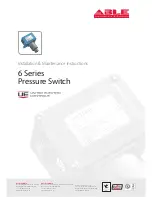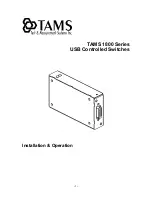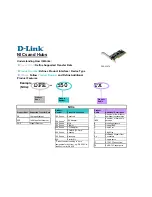
6. Mounting instructions
(ASALMSN in deliver condition)
1) Switch off devices to be assembled
2) Assembling sequence as shown bellow
3) Operation check of NC-contact
Example: A MCB
7. Tripping- and contact-position-indicator:
Tripping indicator changes from white to blue in case of a electrically
tripping and vertical position (to the DIN-rail) of the yellow selector pin.
Horizontal position of selector pin causes white to blue change in any case
of tripping. Either at electrically or mechanically the "tripping indicator"
changes to the function of a "Contact-position-indicator". By this fact it is
possible to get information of the selector pin position when the NHK is
mounted already between other devices and selector cannot be seen.
8. Remark:
Subsequent mounting by the customer needs a operation test after
assembling. Correct operation is given if NC-contacts are closed in case
of both devices are in OFF position. Function test for electrically tripping
can be done without electric voltage as explained in item 5.
* Test must be done before electrifi cation *
In case of incorrect working although mounting instruction has been
watched carefully, please return device to supplier. Don't start repair
yourself! Any warranty is lost in that case!
MOUNTING INSTRUCTION
Tripping Signal Switch ASALMSN
in acc. to IEC/EN 62019
1. Function:
ASALMSN is a retro-fi t auxiliary switch.
The switch provides two signal/alarm functions, dependant upon the
position of the yellow selector pin. The yellow selector pin can be
turned between two positions thus selecting operation of the contacts
through, mechanical operation/electrical tripping or electrical tripping
only.
ASALMSN is delivered with the selector pin in the vertical position (to
the DIN-rail).
This is the “electrical tripping only” position as shown on the printed
picture on the device. It is possible to change operation of changeover-
contact 4.11-4.12/4.14 to “mechanical operation/electrical tripping” by a
90
0
turn of the selector pin.
Operation of contact 1.11-1.12/1.14 is not changeable.
2. Additional feature: "low voltage contact operation".
Very low contact resistance can be reached by the help of selfcleaning
contacts. This is the reason why NHK is able to work under low voltage
conditions down to 5V DC minimum. When contacts are wired in series,
higher voltages are necessary.
3 contacts need 12 volts. 6 contacts in series need 24 V DC minimum
to work correctly. Small tolerances in operational voltages are possible
as samples given above 12 V (instead of 3 x 5 V) and 24 V (instead of
30 V DC).
3. Technical Data:
U
MAX
=
250V AC
max. operational voltage
U
MIN
=
5V DC
min. operational voltage
I
th
=
4A AC
rated thermal current
Util./cat. AC 12...2 A
250 V AC
DC 12...0.5 A
110 V DC
Max. permissible backup-fuse: 4A gL
4. Contacts and terminals:
4.11-4.12/4.14 changeover contact operation changeable.
1.11-1.12/1.14 changeover contact not changeable.
Terminal capacity 1x0,5mm² - 1 x 1,5mm², single wire or fl exibly wire
Terminal capacity 2x0,5mm² - 2 x 1,5mm², single wire
Terminal capacity 1x2,5mm², fl exibly wire,
Terminal screw torque 0,8-1Nm.
5. Operation test "electrically tripping"
Function of changeover contact 4.11-4.12/4.14 can be tested by test push
botton "T". Trip indicator will change from white to blue colour in this case
as well as in case of a regular electric trip. Mechanically moving of the
switch from ON to OFF position will not change colour of trip indicator, if
yellow selector pin is in vertical position to the DIN rail.
GB
6. Montagehinweise
(ASALMSN-Auslieferungszustand)
1) Beide Geräte ausschalten
2) Montage gemäß nachstehender Bildfolge
3) Überprüfung des Ruhekontaktes
Beispiel: A LS
7. Auslöseanzeige/Schaltstellungsanzeige
In der Wahlstellung SEL = senkrecht zur DIN-Schiene, zeigt der Weiß-
Blau-Wechsel der Anzeige nur eine elektrische Auslösung an.
In der Wahlstellung SEL = parallel zur DIN-Schiene, wird die Auslösean-
zeige zu einer Schaltstellungsanzeige, ohne Differenzierung händische/
elektrische Abschaltung. Dadurch ist auch im eingebauten Zustand durch
Handbetätigung des ASALMSN ein Rückschluss auf die nicht mehr
sichtbare Stellung von SEL möglich.
8. Hinweis
Der nachträgliche Anbau durch den Anwender verlangt zur Vermeidung
von Funktionsstörungen eine Montagekontrolle. Richtige Montage liegt
nur dann vor, wenn der Ruhekontakt bei ausgeschaltetem, angekop-
pelten Schalter geschlossen ist. SEL = senkrecht zur DIN-Schiene. Die
elektrische Auslösung ist gemäß Pkt. 5 zu kontrollieren.
* ACHTUNG: VOR INBETRIEBNAHME PRÜFEN!*
Wird trotz Beachtung der Montagehinweise keine einwandfreie Funktion
des Gerätes erreicht, kann dieses schadhaft sein und ist an den Hersteller
einzusenden. Eigene Eingriffe sind nicht zulässig!
MONTAGEANLEITUNG
Auslösesignalschalter ASALMSN
IEC/EN 62019
1. Beschreibung:
Der ASLMSN ist ein, nachträglich an Schalter anbaubarer Hilfsschalter,
der zwischen einer elektrischen Auslösung und einer Hand-Abschal-
tung des angekoppelten Gerätes unterscheiden kann. Es ist somit, je
nach Ausschaltursache, eine unterschiedliche Signalisierung/Alarmie-
rung möglich.
ASALMSN wird mit dem Selektionsknopf in senkrechter Stellung (zur
DIN-Schiene) geliefert. Dies ist die “electrical tripping only” (nur elektrische
Auslösung) Position, wie auf dem seitlich am Gerät abgedruckten Bild
dargestellt. Der Wechslerkontakt 4.11-4.12/4.14 kann durch eine 90 Grad
Drehung des Selektionsknopfes “mechanical operation/electrical tripping”
(Mechanische Betätigung/Elektrische Auslösung) umgestellt werden.
Die Funktion des zweiten Kontaktes ist nicht wählbar. Dieser wird daher
immer händisch oder elektrisch aktiviert.
2. Zusatzfunktion-Kleinspannung:
Durch Kontakt-Relativbewegung zwischen Festkontakt und be-
weglichem Kontakt tritt bei jeder Schaltung eine ”Reinigung” der
Kontaktoberfl äche ein. Damit wird erreicht, dass der Hilfsschalter
ASALMSN auch ein gutes Kleinsignal-Verhalten hat. Die Mindest-Be-
triebsspannung beträgt 5V = je Schaltstrecke. Bei Reihenschaltungen
ist das jeweils Vielfache der Mindest-Betriebsspannung vorzusehen,
zB. bei Serienschaltung von 3 x ASALMSN mindestens 12V DC, bei 6
x ASALMSN mindestens 24V DC. Geringfügige Unterschreitungen auf
den nächsten Nennwert sind zulässig.
3. Technische Daten:
U
MAX
=
250V ~ max. Betriebsspannung
U
MIN
=
5V =
Mindest-Betriebsspannung je Schaltstrecke
I
th
=
4A ~
thermischer Dauerstrom
AC 12-Einsatz 2A
bei 250V ~
DC 12-Einsatz 0,5A bei 110V
Max. Vorsicherung:
4A gL
4. Kontakte/Klemmen:
4.11-4.12/4.14 Wechsler, umschaltbar
1.11-1.12/1.14 Wechsler nicht umschaltbar
Klemmenquerschnitt 1x0,5mm² - 1 x 1,5mm², starr oder fl exibler Leiter
Klemmenquerschnitt 2x0,5mm² - 2 x 1,5mm², starrer Leiter
Klemmenquerschnitt 1x2,5mm², fl exibler Leiter
Drehmoment 0,8-1Nm.
5. Funktionsprüfung ”elektrische Auslösung”
Die Kontaktfunktion des Wechslers kann durch Betätigung der Kontroll-
taste ”T” überprüft werden. In diesem Fall, aber auch bei einer ”echten”
elektrischen Auslösung wechselt die Farbe der Auslöseanzeige von weiß
auf blau. Eine händische Abschaltung verändert die Auslöseanzeige in
"SEL-Position ist senkrecht zur DIN-Schiene" nicht.
D
Eaton Industries (Austria) GmbH, Eugenia 1, 3943 Schrems, Austria
© 2020 by Eaton Industries (Austria) GmbH, www.eaton.eu/documentation
MA-eaton-ASALMSN.indd / 06.2020f / IL019190ZU / 150501428 / All Rights Reserved
www.eaton.com/recycling



